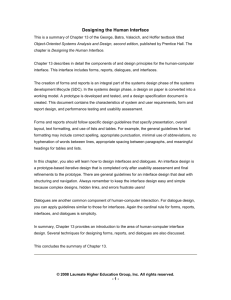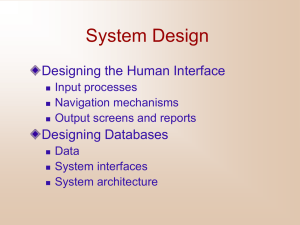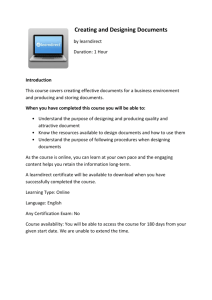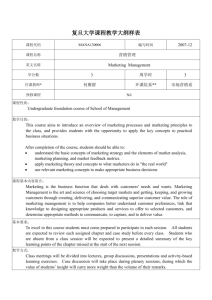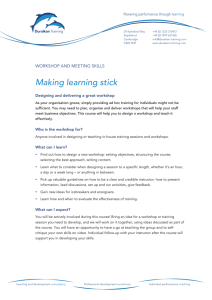Chapter 8
advertisement
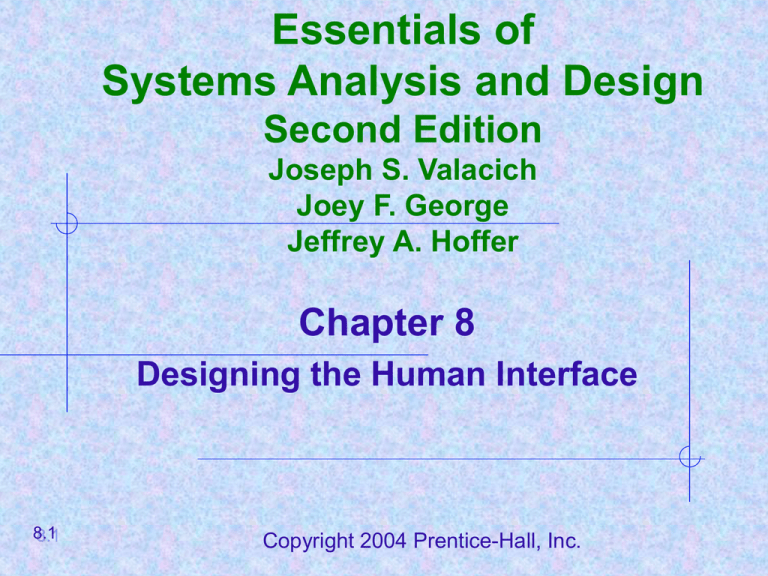
Essentials of Systems Analysis and Design Second Edition Joseph S. Valacich Joey F. George Jeffrey A. Hoffer Chapter 8 Designing the Human Interface 8.1 Copyright 2004 Prentice-Hall, Inc. Learning Objectives Explain the process of designing forms and reports and the deliverables for their creation Discuss general guidelines for formatting text, tables and lists Learn how to effectively format text, tables and lists Explain the process of designing interfaces and dialogues and the deliverables for their creation 8.2 Learning Objectives Discuss the general guidelines for interface design including: 8.3 Layout and design Structuring data entry fields Providing feedback System help Learning Objectives Discuss the design of human-computer dialogues and the use of dialogue diagramming Explain interface design guidelines unique to the design of Internet-based electronic commerce systems 8.4 Designing Forms and Reports System inputs and outputs are produced at the end of the analysis phase Precise appearance was not defined during this phase Forms and reports are integrally related to DFD and E-R diagrams 8.5 Designing Forms and Reports: Key Concepts Form A business document that contains some predefined data and may include some areas where additional data are to be filled in An instance of a form is typically based on one database record Report 8.6 A business document that contains only predefined data A passive document for reading or viewing data Typically contains data from many database records or transactions The Process of Designing Forms and Reports User-focused activity Follows a prototyping approach Requirements determination 8.7 Who will use the form or report? What is the purpose of the form or report? When is the report needed or used? Where does the form or report need to be delivered and used? How many people need to use or view the form or report? The Process of Designing Forms and Reports Prototyping 8.8 Initial prototype is designed from requirements Users review prototype design and either accept the design or request changes If changes are requested, the constructionevaluation-request cycle is repeated until the design is accepted Deliverables and Outcomes Design specifications are major deliverable and contain three sections 1. Narrative 2. Screen Design 3. Testing and usability assessment 8.9 General Formatting Guidelines for Forms and Reports Highlighting 8.10 Use sparingly to draw user to or away from certain information Blinking and audible tones should only be used to highlight critical information requiring user’s immediate attention Methods should be consistently selected and used based upon level of importance of emphasized information 8.11 8.12 General Formatting Guidelines for Forms and Reports Displaying Text 8.13 Display text in mixed upper- and lowercase and use conventional punctuation Use double spacing if space permits. If not, place a blank line between paragraphs Left-justify text and leave a ragged right margin Do not hyphenate words between lines Use abbreviations and acronyms only when they are widely understood by users and are significantly shorter than the full text General Formatting Guidelines for Forms and Reports Displaying tables and lists Labels All columns and rows should have meaningful labels Labels should be separated from other information by using highlighting Redisplay labels when the data extend beyond a single screen or page 8.14 General Formatting Guidelines for Forms and Reports Displaying tables and lists (continued) Formatting columns, rows and text 8.15 Sort in a meaningful order Place a blank line between every 5 rows in long columns Similar information displayed in multiple columns should be sorted vertically Columns should have at least two spaces between them Allow white space on printed reports for user to write notes Use a single typeface, except for emphasis Use same family of typefaces within and across displays and reports Avoid overly fancy fonts General Formatting Guidelines for Forms and Reports Displaying tables and lists (continued) Formatting numeric, textual and alphanumeric data Right-justify numeric data and align columns by decimal points or other delimiter Left-justify textual data. Use short line length, usually 30 to 40 characters per line Break long sequences of alphanumeric data into small groups of three to four characters each 8.16 8.17 8.18 8.19 Designing Interfaces and Dialogues Focus on how information is provided to and captured from users Dialogues are analogous to a conversation between two people A good human-computer interface provides a unifying structure for finding, viewing and invoking the different components of a system 8.20 The Process of Designing Interfaces and Dialogues User-focused activity Parallels form and report design process Employs prototyping methodology 8.21 Collect information Construct prototype Assess usability Make refinements The Process of Designing Interfaces and Dialogues Deliverables Design Specifications Narrative Sample Design Testing and usability assessment 8.22 Designing Interfaces Designing Layouts 8.23 Standard formats similar to paper-based forms and reports should be used Screen navigation on data entry screens should be left-to-right, top-to-bottom as on paper forms Designing Layouts Flexibility and consistency are primary design goals 8.24 Users should be able to move freely between fields Data should not be permanently saved until the user explicitly requests this Each key and command should be assigned to one function Structuring Data Entry 8.25 Entry Never require data that are already online or that can be computed Defaults Units Always provide default values when appropriate Replacement Captioning Format Justify Use character replacement when appropriate Help Provide context-sensitive help when appropriate Make clear the type of data units requested for entry Always place a caption adjacent to fields Provide formatting examples Automatically justify data entries Controlling Data Input One objective of interface design is to reduce data entry errors Role of systems analyst is to anticipate user errors and design features into the system’s interfaces to avoid, detect, and correct data entry mistakes Table 8-9 describes types of data entry errors Table 8-10 lists techniques used by system designers to detect errors 8.26 8.27 8.28 Providing Feedback 1. Status Information Keeps users informed of what is going on in system Displaying status information is especially important if the operation takes longer than a second or two 2. Prompting Cues Best to keep as specific as possible 3. Error and Warning Messages 8.29 Messages should be specific and free of error codes and jargon User should be guided toward a result rather than scolded Use terms familiar to user Be consistent in format and placement of messages Providing Help Place yourself in user’s place when designing help Guidelines Simplicity Help messages should be short and to the point Organization Information in help messages should be easily absorbed by users Demonstrate It is useful to explicitly show users how to perform an operation 8.30 Providing Help Context-Sensitive Help Enables user to get field-specific help Users should always be returned to where they were when requesting help 8.31 Designing Dialogues Dialogue Sequence in which information is displayed to and obtained from a user Primary design guideline is consistency in sequence of actions, keystrokes, and terminology Three-step process 1. Design dialogue sequence 2. Build a prototype 3. Assess usability 8.32 Designing the Dialogue Sequence Define the sequence Have a clear understanding of the user, task, technological and environmental characteristics Dialogue Diagram A formal method for designing and representing human-computer dialogues using box and line diagrams Consists of a box with three sections 1. Top: Unique display reference number used by other displays for referencing dialogue 2. Middle: Contains the name or description of the display 3. Bottom: Contains display reference numbers that can be accessed from the current display 8.33 8.34 Designing Dialogues: Building Prototypes and Assessing Usability Often optional activities Task is simplified by using graphical design environment 8.35 8.36 Electronic Commerce Application: Designing the Human Interface at Pine Valley Furniture Design Guidelines Navigation via cookie crumbs A technique that uses a series of tabs on a Web page to show users where they are and where they have been in the site Tabs are hyperlinks to allow users to move backward easily within the site Two important purposes 8.37 Allows users to navigate to a point previously visited Shows users where they have been and how far they have gone from point of entry into site Electronic Commerce Application: Design Guidelines Lightweight Graphics The use of small images to allow a Web page to be displayed more quickly Forms and Data Integrity 8.38 All forms that record information should be clearly labeled and provide room for input Clear examples of input should be provided to reduce data errors Site must clearly designate which fields are required, which are optional and which have a range of values Electronic Commerce Application : Design Guidelines Template-based HTML 8.39 Templates to display and process common attributes of higher-level, more abstract items Creates an interface that is very easy to maintain Summary Designing Forms and Reports General guidelines for designing forms and reports Formatting text, tables and lists Design guidelines for interfaces 8.40 Layout design Structuring data entry fields Providing feedback Designing help Summary Human-Computer dialogue design Interface design guidelines unique to the Internet 8.41
